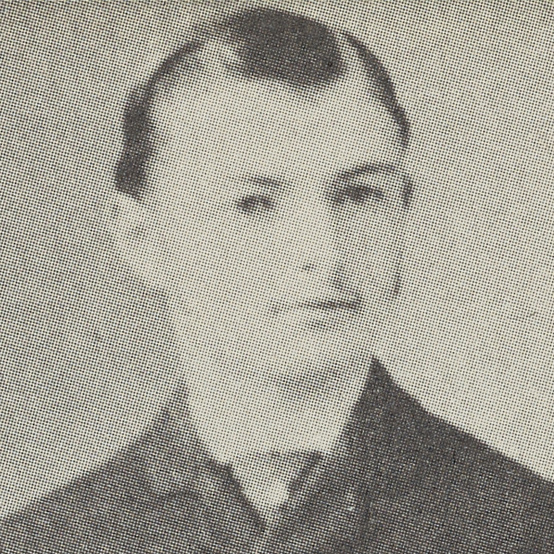Remembered for his kindness, gentleness, and warm-hearted generosity.
Sydney A. Guggenheimer (1863-1937)

The life of Sydney Guggenheimer began at the height of the Civil War, spanned the first World War, and ended as storm clouds were gathering over Europe for yet another one. His lifetime also coincided with the period Henry Ford once suggested should be called the “Age of Edison,” because of that inventor’s great contributions to mankind. Yet Sydney Guggenheimer, whose years encompassed events of historical immensity and great technical advancement, preferred another era. When Sydney Guggenheimer—bachelor, Edwardian gentleman, and dutiful brother—died in 1937, the elegant Victorian home he shared with his two unmarried sisters was still illuminated by gaslight, with a singular exception: Sydney’s own room was lit by electricity.
Sydney’s parents had come to the United States from Germany in the mid-19th century. Jacob H. Guggenheimer was born in Bavaria in 1823, the son of well-to-do parents. He was in his 30s when he married Amalia, who was more than a dozen years his junior. He decided to bring his young bride to the United States to escape the anti-Semitism that made life unpleasant for Jews in Germany. The Guggenheimers settled in New York, where Jacob established an embroidery importing firm. The business thrived from its earliest days.
The Guggenheimers’ first child, Sarah, was born in 1858. Five years later, in 1863, Sydney was born. It was the year of the Battle of Gettysburg, the turning point of the Civil War. Fourteen years passed before the birth of Sydney’s younger sister, Laura. A fourth child, Frieda, who was close to Laura in age, died in 1893 while still in her teens. Through the years, the Guggenheimers were a close-knit family that shared a special interest in music.
At age 17, Sydney went to work in his father’s embroidery business, starting off as a clerk and eventually becoming a salesman. When his father died in 1897 at age 74, it seemed logical that Sydney would become the head of the company as well as the head of the family. But Sydney, a debonair bachelor of 34, who greatly enjoyed being out among people, preferred selling the product to managing the company. Rather than continue his father’s business, he pursued his chosen career as sales representative for various mercantile establishments in New York.
Shortly after his father’s death, Sydney moved his mother and two sisters to a house on upper Park Avenue, only a few blocks from the Lexington Avenue home where they had lived for many years. Within five years, they moved again, this time to a handsome brownstone on West 71st Street, just off fashionable Riverside Drive, where they remained for the rest of their lives.
Jacob Guggenheimer had been a wealthy man at the time of his death. When Amalia died in 1916, the fortune came to Sydney, who proved to be a wise steward of the family wealth. Sydney, Sarah, and Laura had always been close—none had ever married, and at the death of their mother they drew even closer. Sydney was charged with the care of his two sisters and was the undisputed head of the household.
Like many well-to-do New Yorkers of their time, they chose Sundays for entertaining family and friends. The Guggenheimers were liberal in their views and catholic in their interests, and their many friends, who conversed in French and German as well as English, added a cosmopolitan note to such occasions.
Music was one of the principal attractions. Sarah, the eldest of the family and the more serious sister, was a talented pianist; Laura, who was 19 years younger and more outgoing, had a sweet, pleasant voice. Guests often brought along their instruments and joined in for an impromptu concert. Though Sundays were “at-home” days, on weekday evenings, Sydney regularly escorted his sisters to operas at the Metropolitan Opera House and to concerts at Carnegie Hall.
The Guggenheimers also enjoyed traveling. They loved Europe almost as much as they loved New York, perhaps because their roots lay there. Sydney took his sisters on an annual trip to visit the family estate in Germany.
It was not only a lively household but a luxuriously comfortable one. Sydney was noted as a superbly dressed gentleman. His sisters bought their gowns in Paris. And they had servants enough to attend to all their needs.
Still, Sydney and his sisters remained aloof from technical advances at a time when other people of means were enthusiastically acquiring modern luxuries. While Sydney was still a young man, his contemporary, Thomas Edison, had developed a complete system for distribution of electricity for light and power. It culminated in 1881, when he built the world’s first central electric light power plant in New York. The Guggenheimers did not equate such progress with gracious living. Gaslights still burned at 334 W. 71st St. when Sydney, affected little by the “Age of Edison,” died on November 16, 1937.
Sydney’s two sisters lived on in the elegant old home. Without their brother to look after them, to escort them abroad and to musical events, and to bring his interesting and witty friends to visit, they gradually became recluses who clung to lifelong habits. Laura was 68 when she died in 1945. Sarah lived for three more years and died at age 90. At the time of their deaths, Sydney’s old room was still the only one lit by electricity. The rest of the large house remained a relic of the gaslight era.
Among members of his large and far-flung family, Sydney Guggenheimer was remembered for his kindness, his gentleness, his warm-hearted generosity. Poverty distressed him, and he did what he could to help those in need. Sydney made certain that his sisters would be well cared for after his death, and at the same time he made provisions to help others. In his will, he created the Sydney A. Guggenheimer Memorial, to be administered by The New York Community Trust for charitable purposes.
